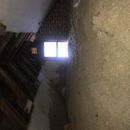Moving Blown in Insulation
Is it okay to move insulation that was blown in on an attic floor into the attic walls? At one time our attic was finished and half of the plaster walls remain. We’d like to use the attic for storage but it’s covered in insulation.
GBA Detail Library
A collection of one thousand construction details organized by climate and house part










Replies
Can't think of a reason why not.
Are you planning to create a conditioned attic? If so, you'll need to insulate the roof as well, and either provide ventilation under the roof sheathing or use closed cell spray foam to create an unvented roof. The former is far more environmentally friendly but requires intake vents at the soffit and an exhaust vent at the ridge.
It's hard to tell what your blown-in insulation is, but it looks like fiberglass. If it's vermiculite, which looks like little flakes of mica, don't touch anything as it likely contains asbestos.
The gable wall would also need to be insulated. Is that brick?
To me, that insulation looks more like cellulose. It's easy to tell if it's cellulose or fiberglass if you can feel it though -- cellulose packs together and gets something of a "crust" on top. Fiberglass stays looser, and will have the same consistency throughout.
You can re-use either cellulose or fiberglass, but you're suppose to run it through a blower again to chew it up and make it loose so that it can resettly correctly. Cellulose especially will tend to make big clumps and not pack together evenly if you try to skip this step. For really small jobs, you can beat the stuff with a garden rake to break it up enough to get it to settly evenly, but I wouldn't want to try that for anything more than maybe a studbay or two size project.
If you use loose fill in the attic roof, you're going to need vent channels, and something like netting to hold the insulation up since I'm assuming the attic "walls" might actually be the roof? I'd probably build the vent channels with 1/2" polyiso if your rafter spacing is close enough. You'd then need to build some kind of ceiling to give you an area you could dense pack.
Bill